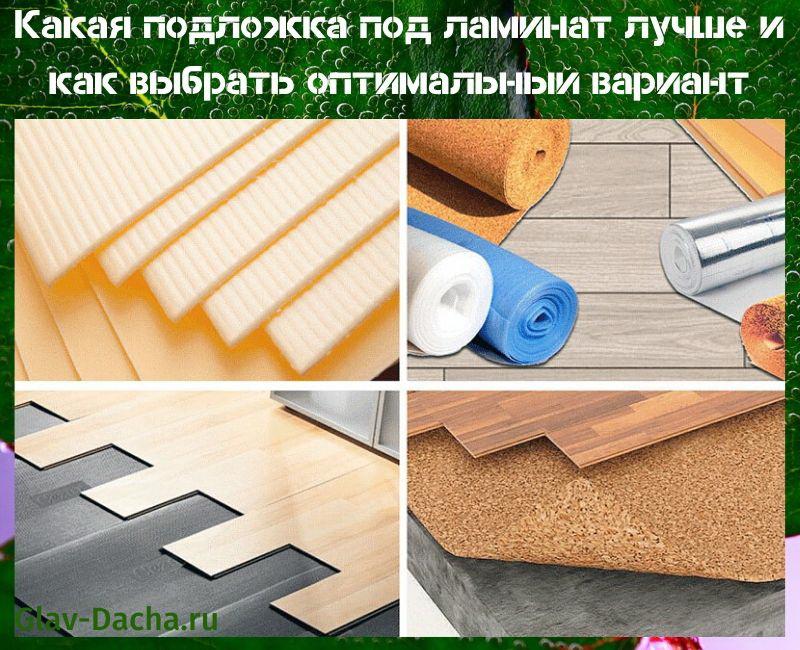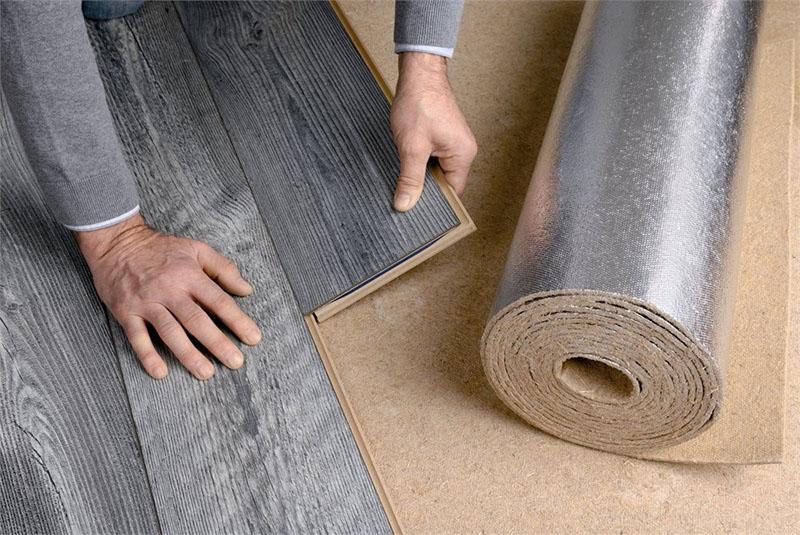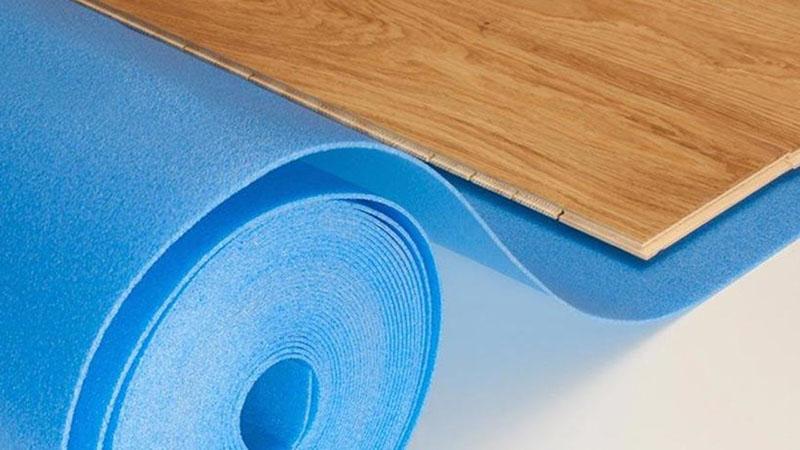What is the best substrate for the laminate and how to choose the best option
 When replacing an old floor in a house with a modern floor covering, the question arises which substrate is better for the laminate. It is impossible to answer it unequivocally, since the construction market provides a wide selection of various materials. Each of them has its own advantages and disadvantages. Let's analyze the main types of laminate substrates and their features.
When replacing an old floor in a house with a modern floor covering, the question arises which substrate is better for the laminate. It is impossible to answer it unequivocally, since the construction market provides a wide selection of various materials. Each of them has its own advantages and disadvantages. Let's analyze the main types of laminate substrates and their features.
Basic functions of a laminate underlay

This element should perform a number of functions:
- Soundproofing. If no backing is placed under the laminate flooring, sounds will be amplified with each step due to the wood or concrete floor. Using a non-woven fabric, you can get rid of squeaks and small noises.
- Leveling the surface. This is one of the key tasks when laying flooring. The presence of a substrate allows you to level minor floor defects, which will have a positive effect on the durability of the locks. The laying technology assumes a height difference of no more than 2 mm. For the best quality flooring, you must use a substrate of the same thickness. It will compensate for possible defects in the subfloor and protect the laminate from damage.
- Waterproofing. Laminate is a pressed paper, so its protection from water is minimal. When exposed to moisture, the panels swell, lose their original attractiveness and necessary shape. The underlayment placed under the laminate will protect the floor from moisture coming from the cement base, thereby increasing the performance of the flooring.
- Reduced vibrating floor movements. Laminate floors are subject to vibrational movements caused by sound waves from transmitted and reflected noise, and by uniform dynamic load on the floor. The substrate allows you to minimize negative consequences, increasing the life of the coating.
- Thermal insulation. All types of substrates, regardless of the material of manufacture, have thermal insulation functions. This allows you to maintain a normal indoor climate, preventing heat loss through the concrete sub-floor.
The underlayment under the laminate is an essential element in the formation of quality flooring. In order for it to last as long as possible, special attention must be paid to the choice of this functional material.
It is almost impossible to do without a backing. The exceptions are situations when a luxury laminate is used. For this flooring, the backing is initially attached to the bottom of the lamella, which means that it does not need to be purchased separately.
What is the best substrate for the laminate: the main varieties
 There is a huge variety of laminate substrates on the market. If we consider them according to the material of manufacture, they can be divided into 2 categories - from natural and synthetic materials.
There is a huge variety of laminate substrates on the market. If we consider them according to the material of manufacture, they can be divided into 2 categories - from natural and synthetic materials.
Each type of substrate is characterized by its positive and negative sides. When choosing a suitable material, it is necessary to carefully study the information to determine which substrate will be the most optimal option.
Polyethylene foam (isolone)
 The presented version is characterized by a low level of strength, with regular loads it is easily torn and compressed. In view of these features, izolon is considered one of the cheapest types of laminate substrates.
The presented version is characterized by a low level of strength, with regular loads it is easily torn and compressed. In view of these features, izolon is considered one of the cheapest types of laminate substrates.
Polyethylene foam has the following advantages:
- high level of moisture resistance;
- good noise insulation properties;
- ease of installation, you can connect the substrate using ordinary stationery tape;
- izolon does an excellent job of leveling small defects in the sub floor;
- the material is immune to most chemicals.
Along with positive characteristics, this type of substrate has some disadvantages:
- build-up of static electricity;
- low performance parameters;
- susceptibility to destruction during prolonged exposure to ultraviolet radiation.
Izolon is not recommended for use when laying an expensive laminate.
This material is characterized by low performance, which is why the durability of the flooring is small. The exception is when the isolon is laid on plywood, designed to make the floor surface as flat as possible.
Cork substrates
 Pressed cork backing belongs to the category of expensive materials. It is a material produced in the form of sheets and rolls. Several variations of cork substrates are available to consumers - with rubber, bitumen and cork chips.
Pressed cork backing belongs to the category of expensive materials. It is a material produced in the form of sheets and rolls. Several variations of cork substrates are available to consumers - with rubber, bitumen and cork chips.
The presented option has the following advantages:
- Restoration of the original form. Being in a compressed state for a long period of time, a sheet cork substrate is able to restore its shape in the shortest possible time.
- The plug is characterized by a low thermal conductivity parameter. This material will provide excellent thermal insulation, therefore it can be used in cool rooms.
- the material has good resilience and elasticity. Thanks to this, the durability of the laminate flooring is significantly increased;
- cork is a natural material. It is absolutely environmentally friendly, while not afraid of rotting and other corrosive processes.
When choosing a cork substrate, you should be aware of its negative characteristics:
- the material allows water to pass through, therefore excess moisture can accumulate under the cork;
- the material is characterized by a high level of density, which is why it is impossible to lay it on substrates with deviations of more than 2 mm without preliminary leveling.
The cork backing is not recommended for use in rooms with high humidity levels. In addition, it is characterized by a rather high cost, which is not always suitable for consumers.
It is recommended to lay the cork backing on a perfectly flat floor. Otherwise, it will quickly deform and fail. Before installation, the subfloor should be treated with a water-repellent soil mixture.
Bituminous cork underlay
 Bituminous cork underlayment is a type of cork underlay for laminate flooring. It is made of kraft paper, which is pre-impregnated with bitumen and covered with fine cork chips.
Bituminous cork underlayment is a type of cork underlay for laminate flooring. It is made of kraft paper, which is pre-impregnated with bitumen and covered with fine cork chips.
This type of backing has the same advantages and disadvantages as cork. However, due to the use of bitumen, the substrate has a higher resistance to water.
Coniferous substrate
 The classic version of the substrate made of natural wood coniferous trees. Spruce is often used for it. The material is characterized by a porous texture, which enhances its sound insulation function.
The classic version of the substrate made of natural wood coniferous trees. Spruce is often used for it. The material is characterized by a porous texture, which enhances its sound insulation function.
Natural wood absorbs condensation well, levels minor roughness of the floor. It is recommended to use it if the subfloor is made of concrete.The only drawback of this substrate is its high cost, which is why it is recommended to use it when laying an expensive laminate.
Expanded polystyrene
 One of the most optimal options, characterized by excellent quality and affordable price. The substrate is made of extruded polystyrene foam, which has excellent sound-absorbing functions.
One of the most optimal options, characterized by excellent quality and affordable price. The substrate is made of extruded polystyrene foam, which has excellent sound-absorbing functions.
Due to the porous texture of the material, the backing absorbs condensation, protecting the laminate from high humidity. This allows it to be installed without an additional waterproofing layer. The material is characterized by high elasticity and is able to quickly restore its original shape.
Combined underlay
 It is a combination of polyethylene and polystyrene foam. The substrate consists of 3 layers. The upper and lower layers are made of polyethylene, the middle layer is represented by small balls of expanded polystyrene.
It is a combination of polyethylene and polystyrene foam. The substrate consists of 3 layers. The upper and lower layers are made of polyethylene, the middle layer is represented by small balls of expanded polystyrene.
The presence of a plastic film at the top does not allow moisture to pass through, protecting laminates from excessive moisture. The bottom polyethylene layer performs a similar function, except that it allows condensation to pass through to expanded polystyrene... Thanks to this, water is discharged outside through the technological gaps, without getting to the laminate. This feature of the substrate allows you to exclude the use of additional waterproofing when installing the floor covering.
The combined underlay smooths out unevenness of the base well, is characterized by a long service life.
However, when choosing this option, it must be borne in mind that it is made from styrene. This substance, when evaporated, has a negative effect on overall health. You can get rid of the problem thanks to daily ventilation.
Laminate underlay: selection criteria
 It is impossible to say unequivocally which substrate for a laminate is better. Each type of lining has its own characteristics, advantages and disadvantages.
It is impossible to say unequivocally which substrate for a laminate is better. Each type of lining has its own characteristics, advantages and disadvantages.
Experts recommend focusing on a number of key criteria when choosing a suitable option:
- the cost of building material;
- permissible operational period;
- environmental friendliness;
- resistance to corrosion processes, fungi and rodents;
- form of release (roll or sheet support).
Particular attention should also be paid to the thickness of the substrate. Most users believe that this value should be the maximum. In practice, this is absolutely not the case. With a thick substrate, the laminate will be strongly compressed by loads, which over time will entail deformation of the coating.
To purchase the highest quality substrate, you must focus on observing the following rules:
- The permissible substrate thickness varies between 2-5 mm. When choosing a suitable option, it is necessary to take into account the presence of floor defects. If the base is unnecessarily uneven, it is better to opt for a thicker base. If it is as flat as possible, without visible defects, a thin substrate would be ideal.
- The thickness of the substrate directly depends on the materials of manufacture. The standard thickness of the cork backing does not exceed 2 mm. Giving preference to polyethylene, you must purchase a product with a minimum thickness of 5 mm. This is due to the fact that over time, the polyethylene will sag.
- It is advisable to use a substrate with a thickness of more than 5 mm in rooms where there is a need for a significant increase in heat and sound insulation indicators.
Experts do not recommend covering the subfloor with underlay that is more than 5 mm thick. This is due to the fact that over time the laminate joints will be damaged.
Laminate is originally a versatile floor covering designed to resist flex. If you put a thick lining under it, over time, defects will appear on the coating, the floor will begin to creak.
Features of mounting the substrate
 Laying the underlayment under the laminate is a simple procedure that any user can handle.
Laying the underlayment under the laminate is a simple procedure that any user can handle.
The process consists of several fundamental steps:
- A thin layer of polyethylene must be laid on a fresh concrete screed. If the subfloor is old, this recommendation may not be followed.
- All dirt is removed from the floor. It is recommended to vacuum the area to get rid of dust accumulations. The substrate must be as clean and dry as possible before laying the underlay.

- On the prepared surface, a waterproofing film is laid with an overlap with an approach to the walls. After that, you can start laying the substrate. You can cut the material with ordinary scissors or a construction knife. If the underlay has corrugation, it should be at the bottom in order to level the unevenness of the floor as much as possible.
- The connecting seams must be glued with stationery tape without fail. After that, you can proceed to the installation of the laminate.

The underlay should be installed on a perfectly dry floor covering.
To check if the concrete screed has dried, it is necessary to lay polyethylene on the base and leave it overnight. If no condensation has formed under the bag in the morning, you can proceed with the installation of the floor covering.
The substrate is characterized by a small mass, therefore, when laying the laminate, it may shift. To avoid this, it is recommended to secure the lining with double-sided tape.